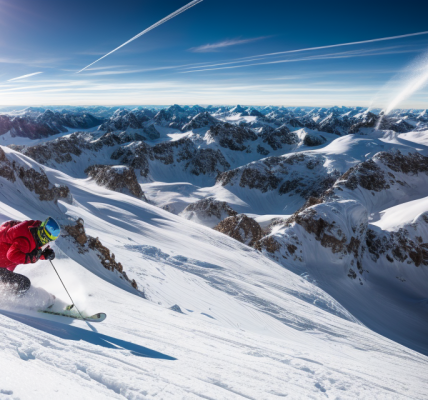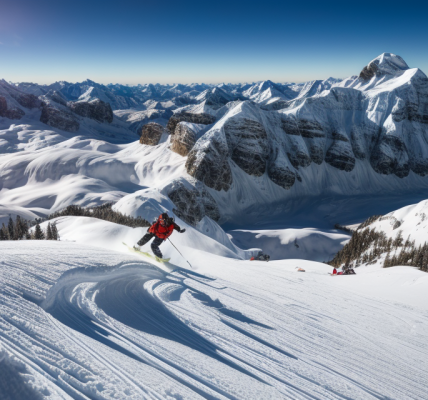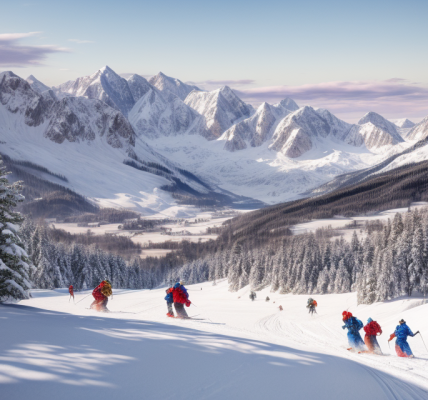Are you planning a ski vacation but not sure which month to go? Look no further! This guide will help you determine the best month for skiing, so you can make the most of your trip. From the best snow conditions to the busiest times, we’ll cover it all. So whether you’re a beginner or a seasoned pro, get ready to hit the slopes in the ultimate ski destination. Let’s dive in!
Factors Affecting Skiing Conditions
Weather Patterns
Temperature
The temperature of the air plays a significant role in determining the quality of skiing conditions. A temperature that is too high can lead to slushy conditions, while a temperature that is too low can result in hard and icy surfaces. Ideally, the temperature should be just below freezing to create a perfect balance of snow and ice.
Snowfall
The amount of snowfall is another crucial factor in determining the best month for skiing. Adequate snowfall is necessary to create a soft and powdery surface that is ideal for skiing. However, too much snowfall can lead to avalanches and other dangerous conditions, while too little snowfall can result in icy and hard surfaces.
Wind
Wind can also significantly impact skiing conditions. Strong winds can create a wind blown snow that can make the slopes icy and difficult to navigate. On the other hand, light winds can create the perfect conditions for skiing by leaving a soft and powdery surface. Therefore, it is essential to consider the wind speed and direction when choosing the best month for skiing.
Time of Day
Sunrise and Sunset
The timing of sunrise and sunset plays a crucial role in determining the best time for skiing. Early morning and late afternoon skiing can offer ideal conditions due to the angle of the sun’s rays. During these times, the sun’s rays are more diffuse, creating softer shadows and a more even distribution of light. This results in better visibility and improved conditions for skiers, as the snow is less likely to be affected by the harsh midday sun.
Shadows and Light
The position of the sun at different times of the day also affects the amount and intensity of shadows on the ski slopes. During early morning and late afternoon skiing, the sun’s position creates longer shadows that add visual interest to the landscape. These shadows can also help to highlight the contours of the terrain, making it easier for skiers to navigate the slopes.
In addition, the longer shadows created during early morning and late afternoon skiing can help to reduce glare and reflection, making it easier for skiers to see and be seen on the mountain. This improved visibility can enhance the overall skiing experience and contribute to a more enjoyable and safe time on the slopes.
Terrain
Elevation
Elevation plays a significant role in determining the quality of skiing conditions. Generally, the higher the elevation, the more reliable the snowfall and the longer the ski season. Ski resorts located at higher elevations, such as those in the Rocky Mountains or the Swiss Alps, typically offer better skiing conditions than those at lower elevations. However, it’s important to note that higher elevations also mean thinner air, which can affect the physical performance of skiers.
Orientation
The orientation of a ski resort’s terrain can also impact the quality of skiing conditions. Resorts that are located in a northerly direction tend to receive more consistent snowfall, as they are more exposed to the prevailing winds from the north. On the other hand, resorts located in a southerly direction tend to have less consistent snowfall, as they are sheltered from the prevailing winds. Additionally, the orientation of a resort’s terrain can impact the amount of sunshine it receives, which can affect the quality of the snow and the overall skiing experience.
Topography
The topography of a ski resort’s terrain can also impact the quality of skiing conditions. Resorts with a diverse topography, featuring a mix of gentle slopes, steep chutes, and tree skiing, tend to offer a more varied and exciting skiing experience. However, resorts with a more uniform topography may offer more consistent skiing conditions, but can become repetitive for experienced skiers. The topography of a resort’s terrain can also impact the amount of snow that is retained, as well as the speed at which it is replenished, which can affect the overall skiing experience.
Ski Resorts and Travel
Top Ski Destinations
North America
- [Location Name]
- [Skiable Area/Vertical Drop]
- [Number of Trails/Lifts]
- [Terrain Difficulty]
- [Average Snowfall]
Europe
Asia
Australia
Planning Your Trip
Choosing the Right Destination
When planning your ski trip, it’s important to choose a destination that offers the type of terrain and snow conditions you’re looking for. Some ski resorts are better suited for beginners, while others cater to advanced skiers and snowboarders. Research the different resorts and their trail difficulty levels, as well as their snowfall averages, to find the perfect match for your skill level and preferences.
Booking Accommodations
Once you’ve chosen your destination, it’s time to book your accommodations. Ski resorts offer a variety of lodging options, from cozy bed and breakfasts to luxurious hotels and condos. Consider your budget and the number of people in your group when selecting your accommodations. Don’t forget to take into account the proximity to the slopes and any additional amenities, such as a swimming pool or hot tub.
Transportation and Logistics
Transportation is a crucial aspect of planning your ski trip. If you’re flying, make sure to book your flights well in advance to secure the best rates. Some ski resorts offer shuttle services from the airport, while others require you to rent a car or arrange for a private shuttle. Additionally, consider the distance between your accommodations and the ski resort, as well as the availability of public transportation.
Equipment and Clothing
To make the most of your ski trip, it’s important to have the right equipment and clothing. If you don’t already own ski gear, you’ll need to rent or purchase skis, boots, and poles, as well as a ski jacket and pants. Make sure your clothing is warm and waterproof, and bring extra layers for when you take breaks or après ski. Don’t forget to pack sunscreen, sunglasses, and a hat to protect yourself from the elements.
On-Mountain Experience
Lift Tickets and Passes
When it comes to the on-mountain experience, one of the most important factors to consider is the cost of lift tickets and passes. The cost of lift tickets can vary greatly depending on the ski resort and the time of year. Some ski resorts offer discounted lift tickets during off-peak times, while others may charge premium prices during peak seasons. It’s important to do your research and compare prices across different ski resorts to find the best deal.
Ski Schools and Lessons
Another important aspect of the on-mountain experience is the quality of ski schools and lessons offered at the resort. Some ski resorts have world-class ski schools with experienced instructors who can help you improve your skills and techniques. It’s important to consider your ski level and goals when choosing a ski school or lesson. Whether you’re a beginner looking to learn how to ski or an advanced skier looking to improve your technique, finding the right ski school or lesson can make a big difference in your overall experience.
Mountain Restaurants and Apres-Ski
The quality and variety of mountain restaurants and apres-ski options can also play a big role in your on-mountain experience. Some ski resorts have a wide range of dining options, from casual cafes to gourmet restaurants, while others may have limited options. It’s important to consider your dining preferences and budget when choosing a ski resort. Additionally, the apres-ski scene can be just as important as the skiing itself for some people. Some ski resorts have a lively apres-ski scene with live music and entertainment, while others may be more low-key.
Safety and Responsibility
Finally, safety and responsibility should always be a top priority when it comes to the on-mountain experience. Skiing can be a dangerous sport, and it’s important to take the necessary precautions to stay safe. This includes wearing appropriate ski gear, following ski patrol instructions, and being aware of your surroundings at all times. Additionally, it’s important to be responsible on the mountain and respect the environment and other skiers. This includes not littering, staying on designated trails, and not skiing outside of your ability level.
Tips and Tricks
Preparing for Cold Weather
Before hitting the slopes, it’s important to prepare for the cold weather. This includes dressing in layers, wearing appropriate footwear, and bringing along warm accessories such as gloves, hats, and scarves. It’s also a good idea to pack a small backpack with essentials like sunscreen, lip balm, and snacks.
Skiing Etiquette
Skiing etiquette is important for a safe and enjoyable experience for everyone on the mountain. Some basic rules include staying in control at all times, avoiding high-speed runs near other skiers, and always yielding to uphill traffic. It’s also important to respect the boundaries of ski areas and avoid skiing outside of designated trails.
Adapting to Different Conditions
Skiing conditions can vary greatly depending on the time of day, weather, and snow conditions. It’s important to adapt your skiing style to the conditions, whether it’s adjusting your speed or adjusting your line to avoid icy patches. Being able to adapt to different conditions can help you become a better skier and avoid accidents.
Staying Active and Fit
Being in good physical shape can help you enjoy your skiing experience and prevent injuries. It’s important to stay active and fit leading up to your trip, whether it’s through regular exercise or other outdoor activities. This can help you build strength, endurance, and flexibility, which can all contribute to a safer and more enjoyable skiing experience.
Recap of Key Points
- When planning a ski trip, it’s important to consider the best time to go for optimal conditions and experience.
- The best month for skiing can vary depending on the location of the ski resort and the specific weather patterns of the region.
- Factors that can impact the quality of the skiing experience include temperature, snowfall, and weather conditions.
- Understanding the unique characteristics of each ski resort and the surrounding climate can help determine the best time to visit for ideal skiing conditions.
- Consider factors such as altitude, terrain, and snowmaking capabilities when evaluating the best time to visit a ski resort.
- By taking into account these factors and conducting research on the specific ski resort, travelers can increase their chances of having an enjoyable and memorable skiing experience.
Final Thoughts and Recommendations
When it comes to finding the best month for skiing, there are a few key things to keep in mind. First and foremost, it’s important to consider the location of the ski resort you’re interested in. Different resorts may have different peak ski seasons based on factors like location, altitude, and climate.
Additionally, it’s important to consider the type of skier you are and what you’re looking for in a ski vacation. Do you prefer well-groomed runs or fresh powder? Are you interested in a party atmosphere or a more tranquil, family-friendly experience?
Once you’ve considered these factors, you can start to narrow down your options and choose the best month for your ski vacation. Keep in mind that the ski season can vary from year to year based on factors like weather patterns and snowfall, so it’s always a good idea to stay flexible and be prepared for changes.
Ultimately, the best month for skiing will depend on your individual preferences and the specific ski resort you’re interested in. By doing your research and considering all of the factors that can impact your ski vacation, you can find the perfect time to hit the slopes and have an unforgettable experience.
FAQs
1. What is the best month to go skiing?
The best month to go skiing depends on various factors such as location, weather conditions, and personal preferences. Generally, December to February are the most popular months for skiing in the Northern Hemisphere, while June to August are the best months for skiing in the Southern Hemisphere. However, it’s important to research the specific location and time of year you’re planning to visit to determine the best time for skiing.
2. How do I choose the best month for skiing?
To choose the best month for skiing, consider factors such as the location of the ski resort, the altitude of the resort, and the climate of the region. You should also take into account your personal preferences, such as the amount of snowfall and the availability of lift tickets. It’s recommended to research the historical snowfall and weather patterns of the area to determine the best time for skiing.
3. What is the ski season in different parts of the world?
The ski season in the Northern Hemisphere typically runs from November to April, while the ski season in the Southern Hemisphere runs from June to October. However, the exact dates can vary depending on the location and weather conditions. Some ski resorts may also offer extended seasons or summer skiing options, depending on the availability of snow.
4. How do I prepare for skiing during the best month?
To prepare for skiing during the best month, make sure to pack appropriate clothing and equipment, such as warm layers, gloves, and a helmet. It’s also important to stay hydrated and get plenty of rest to ensure you’re ready for a day of skiing. Additionally, it’s a good idea to familiarize yourself with the ski resort and its policies, such as lift ticket availability and ski rental options.
5. Are there any advantages to skiing during the off-season?
Yes, there are several advantages to skiing during the off-season, including reduced prices on lift tickets and accommodations, fewer crowds, and better snow conditions due to the natural snowfall that has accumulated over the summer. However, it’s important to note that some ski resorts may not be open during the off-season or may have limited lift and trail availability.



